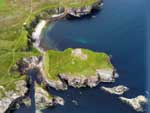 The Brough of Deerness is a sea stack in east Mainland, Orkney, Scotland. Its grass-covered top, surrounded by 30m cliffs, holds the remains of an enigmatic Viking Age settlement interpreted as a chiefly stronghold or monastery. The co-occurrence of a Viking Age church and approximately 30 associated buildings in such an exposed location make it a remarkable site.
The Brough of Deerness is a sea stack in east Mainland, Orkney, Scotland. Its grass-covered top, surrounded by 30m cliffs, holds the remains of an enigmatic Viking Age settlement interpreted as a chiefly stronghold or monastery. The co-occurrence of a Viking Age church and approximately 30 associated buildings in such an exposed location make it a remarkable site.
Past excavation, by Christopher Morris, focussed on the area around the partially upstanding stone church. Under it was discovered the remains of an earlier timber chapel, predating a layer containing an Anglo-Saxon coin minted between AD 959 and 975. This chapel is therefore among the earliest known evidence for Viking Age Christianity in the North Atlantic region — possibly predating the traditional conversion date of AD 995.
Although unique in many respects, the site belongs to a group of Early Historic islet, promontory, and stack settlements known from the Northern Isles, other parts of coastal Scotland, and the Irish Sea province (the ‘Early Historic’ in Scotland means 6th-12th centuries AD). In terms of size and access, they range from small low-lying islands such as Iona to tiny inaccessible stacks such as the ‘Castle’ of Burrian in Orkney. In terms of function, interpretations vary from aristocratic strongholds to monasteries — with the interrelatedness of power and religion in the Early Historic period blurring the distinction. The choice of these exposed sites must have been significant. At the Brough of Deerness, the poles of our heavy-duty army tent were turned to matchwood twice in five weeks — and that was in July!
It is clear that some sites served as centres of power — like Burghead and Dumbarton in Scotland, and St. Patrick’s Isle, Peel, on the Isle of Man. These settlements have been associated with the kings of Pictland, Strathclyde, and Man respectively. Others were clearly monastic. Well-known Scottish examples include Iona, Inchmarnock, and the Isle of May. The best-known site in the Northern Isles is the Brough of Birsay. It is a relatively large tidal islet off the north-west coast of Mainland, Orkney. Historical evidence indicates that in the 11th century it was either the primary seat of the earls and bishops of Orkney or part of a multi-focal settlement (including mainland sites) that collectively included these functions. Based on archaeological evidence, its role as a central place had begun in Pictish times.
For the full article, see Current Archaeology 228.



